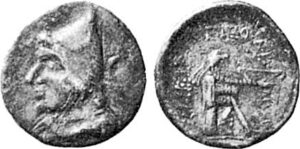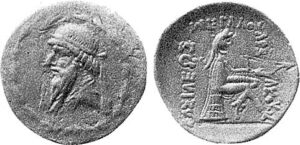Mihrdāt I is one of the most important Arsacid-Parthian kings. He continued the expansion of Aškān I and raised the Arsacid empire to an imperial position. His achievements and character traits immortalized him in the glorious annals of the Parthian narrative.
A Narrative by Varan
Edited and Enhanced by Pīroz
Developments in the East
In 171 B.C. Mihrdāt I, son of Friapātak, came to power. Before Mihrdāt I (gr. Mithridates I, 171 – 138 BC), the Arsacid kings Frahāt I and Aškān II had been busy securing the reconquered territories. Mihrdāt, however, devoted himself to enlarging the kingdom.
In the east, Eranian provinces such as Aria, Zrangiana, and Arachosia had rebelled against the Bactrians with Mihrdāt’s support. Mihrdat I, for his part, defeated the Greko-Bactrians, made them his vassals and liberated the territories (Ellerbrock, Winkelmann 2012: 55). After his victory over the Bactrians in the east, Mihrdāt turned to the western territories of his kingdom. In 148 BC he attacked the Seleucids. In one stroke, he captured all of Media and Ekbatāna, the former capital of the Medes. The minting of coins by Mihrdāt I in Ekbatāna indicates the new center of power and the symbolic weight of the victory for the Parthians (ibid.). The beginning of its success story marks the birth of the Arsacid Parthian Empire.
Western Front
With the incorporation of Media into the Arsacid-Parthian Empire, the country now bordered Mesopotamia, which was still under Seleucid control. The Seleucid Empire was ruled at this time by Demetrios II (160 – 125 BC), who allied with the Egyptians and Elamites in 141 BC and launched an attack against Parthia. Mihrdāt I, however, opposed the tripartite alliance and defeated Demetrios. In the battle, Demetrios was captured and taken to Vergana. Mihrdāt treated his defeated enemy with dignity and great hospitality. Soon after, he had his daughter Rhodogune married to the former Seleucid king (Brosius 2006: 89, Bivar 1983: 35, Shayegan 2007: 83–103).
The Shahanshah
With the victories in the east and west, the Arsacid Empire reached the Indus River in the southeast (Garthwaite 2005: 76, Bivar 1983: 35) and in the west, from 141 BC onwards, Babylonia was incorporated into the Empire (Ellerbrock, Winkelmann 2012: 55) . Thus, the kingdom became an empire that, thanks to the achievements of Mihrdāt, would retain this characteristic for many centuries to come.

Fig. 1: Diademed head of Arsaces l., wearing kyrbasia. Reverse: Arsaces seated, holding bow. Minted during the reign of Mihrdat I. Sylloge Nummorum Graecorum.
In keeping with his achievements, Mihrdāt I was the first Arsacid Parthian king to be crowned Shahanshah (Jakobs 2010: 54), King of Kings. He bore this title in addition to the traditional designation as Ašk (Arsacid), sending the message of his claim to power in Eran. Mihrdāt I thus became the symbolic transformer of the kingdom into an empire.
Mihrdāt achievements combined several qualities in leadership. While Ašk an I conformed to the popular Eranian ideal of self-empowerment – from common man to king – Mihrdāt introduced the royal ideal of the imperial Shahanshah. Thus, both the popular and the royal were united in the Arsacid bloodline, ushering in an unprecedented symbolic rule.

Fig. 2: Portrait head of Mihrdat I, with diadem. Reverse: Arsaces seated, holding bow. Minted during the reign of Mihrdat I. Sylloge Nummorum Graecorum.
The government was consolidated with the establishment of Megistan. Under Mihrdāt I, the Megistan, the first parliament of Eran, was created in 137 BC. It consisted basically of two parts, to which on the one hand the sages and magi belonged, on the other hand the feudals and nobles of the great Parthian houses. The king represented the entire empire. Thus the social-religious and also the military-economic aspects of the Parthian empire were integrated into the decision-making of the empire, which stabilized the empire.
It was due to these territorial expansions that a demographic change now occurred in the empire. This was particularly noticeable in the province of Media, where cultural change was very rapid. With the incorporation of Media, the Medo-Parthian synthesis was completed and Media was fully Parthianized. Since the Arsacid period now, Media was known as “Pahla” (Arsacidic-Parthian for “Parthia”) (Henning 1958: 95). The fact that besides the first province Pahlava (Parthava) the neighboring province was named Pahla shows that the demographic expansion of the Parthian ethnic group had started very early and was favored by given circumstances. Thus, already about 2,000 years ago, the empire of the Parthians from the northeastern steppes to the borders of northern Mesopotamia, was both, politically and ethnically Parthian.
List of References
Bivar, A. D. H. 1983. The Political History of Iran under the Arsacids, in The Cambridge History of Iran, The Seleucid, Parthian and Sasanian Periods, Part 1 – Political History. Cambridge University Press.
Brosius, Maria. 2006. The Persians. Routledge.
Ellerbrock, U., Winkelmann, S. 2012. Die Parther – Die vergessene Grossmacht. Philipp von Zabern Verlag, Darmstadt.
Garthwaite, Gene Ralph. 2005. The Persians. Oxford & Carlton: Blackwell Publishing.
Henning, Walter Bruno. 1958. Mitteliranisch. E. J. Brill.
Jacobs, B. 2010. Quellen zur Geschichte des Partherreiches – Textsammlung mit Übersetzungen und Kommentaren I, Novum Testamentum et Orbis Antiquus, in Studien zur Umwelt des Neuen Testaments 83. Göttingen, Oakville.
Shayegan, M. Rahim. 2007. On Demetrius II Nicator’s Arsacid Captivity and Second Rule, in Bulletin of the Asia Institute 17, 2003 [2007]: 83–103. Bulletin of the Asia Institute.


